The iPad Air Review
by Anand Lal Shimpi on October 29, 2013 9:00 PM ESTGPU Performance
Since the iPad Air uses the same A7 silicon as the iPhone 5s, it also uses the same on-die GPU as the 5s: IMG’s PowerVR G6430. This is a 4-cluster configuration of IMG’s latest graphics hardware, running at some relatively high frequency. I already went into some detail on the G6430 in our 5s review so I won’t rehash that here, but we’re basically looking at a shift to a more efficient scalar architecture.
I still don’t have confirmations of clock speeds, but I believe we’re looking at a max GPU clock of around 450MHz. As you’ll see from the results below, there’s a small difference in performance between the iPad Air and iPhone 5s in terms of peak GPU performance - implying very similar clocks. The difference is the iPad Air should be able to sustain its max frequency longer than the iPhone 5s can.
| Mobile SoC GPU Comparison | ||||||||||||
| PowerVR SGX 554MP4 | PowerVR G6430 | PowerVR G6430 | ||||||||||
| Used In | iPad 4 | iPhone 5s | iPad Air | |||||||||
| SIMD Name | USSE2 | USC | USC | |||||||||
| # of SIMDs | 32 | 4 | 4 | |||||||||
| MADs per SIMD | 4 | 32 | 32 | |||||||||
| Total MADs | 128 | 128 | 128 | |||||||||
| GFLOPS @ 300MHz | 76.8 GFLOPS | 76.8 GFLOPS | 76.8 GFLOPS | |||||||||
| GFLOPS as Shipping | 68.1 GFLOPS (?) | 115.2 GFLOPS | 115.2 GFLOPS | |||||||||
Since we’re talking about an A7 here and not an X-series SoC, there’s still only a 64-bit wide memory interface. As memory bandwidth is a key enabler of GPU performance I was curious to see how GPU performance compared to the outgoing iPad 4 with its much wider memory interface. Do keep in mind that the A7 does include a large system cache on-die, which can help improve effective memory bandwidth.
GFXBench 2.7
We'll start our GPU performance analysis with a look at low level results using GFXBench/GLBenchmark 2.7. The low level tests, particularly the offscreen ones, should give us some idea as to whether or not there's any increase in GPU frequency for the iPad Air vs. iPhone 5s implementations of A7.
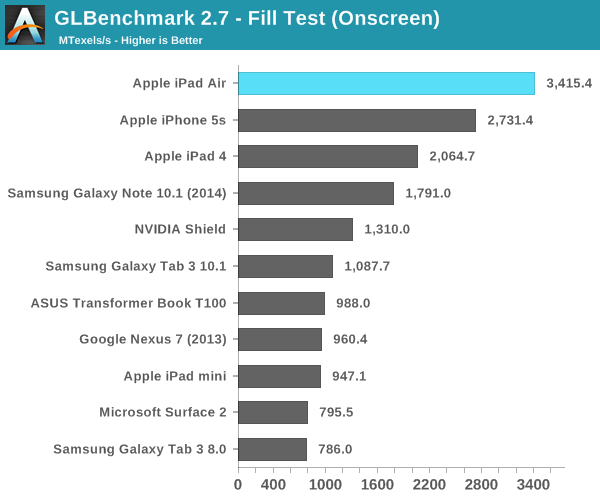
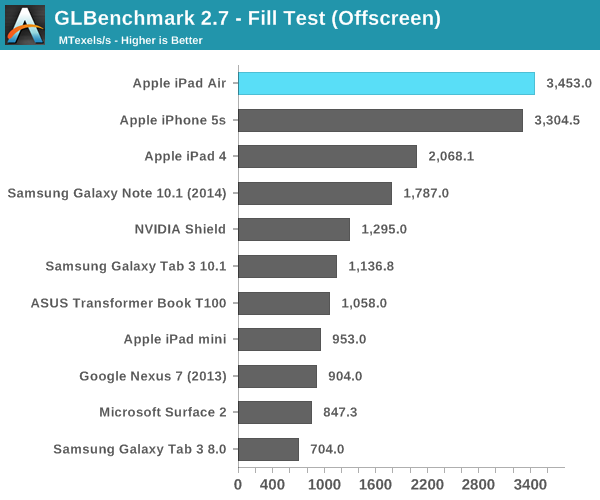
Looking at the fill rate results, there's a 4.5% increase in performance compared to the iPhone 5s. That could be the magnitude of clock increase that we're seeing between A7s. Apple could very well be relying on more thermal headroom in the iPad Air to provide any real world GPU performance advantages over the iPhone 5s.
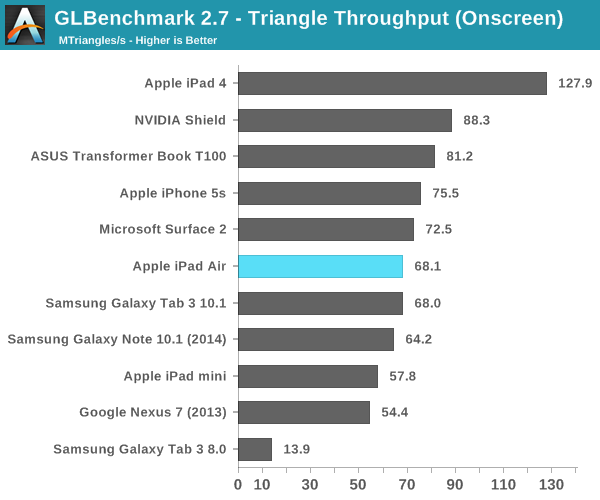

We see an even smaller gap between the Air and 5s in the triangle throughput tests (2.9%). There doesn't seem to be any substantial difference in GPU frequency between A7 implementations here. The regression in triangle rate performance compared to the iPad 4 is explained by differences in how Series 6 and Series 5XT GPUs scale in width. Whereas 5XT replicated nearly the entire GPU for "multi-core" versions, multi-cluster versions of Rogue only replicate at the shader array. The result? We don't see the same sort of peak triangle setup scaling we did back on multi-core 5XT parts. I'm not sure I'm particularly happy with the magnitude of the regression here, but I haven't seen any real world cases where it matters yet.
Next up are the game simulation tests. We'll start with the more strenuous of the two: T-Rex HD.
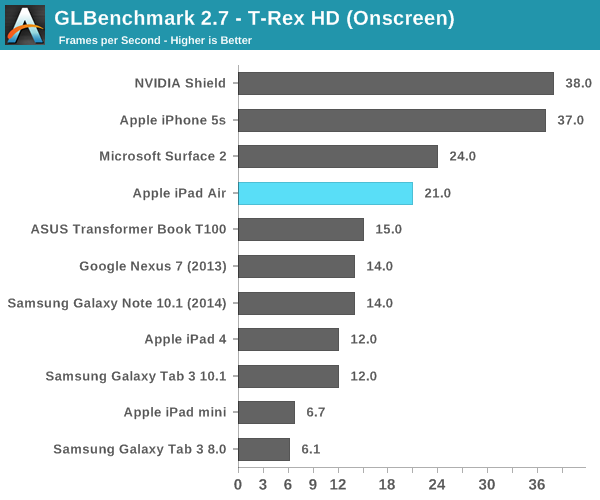
Here we get closer to Apple's claims of a 2x increase in performance. The iPad Air delivers 75% more performance than the iPad 4 in this test. Once again the iPhone 5s pulls ahead but that's because the onscreen tests render at display resolution, which is lower on the 5s.
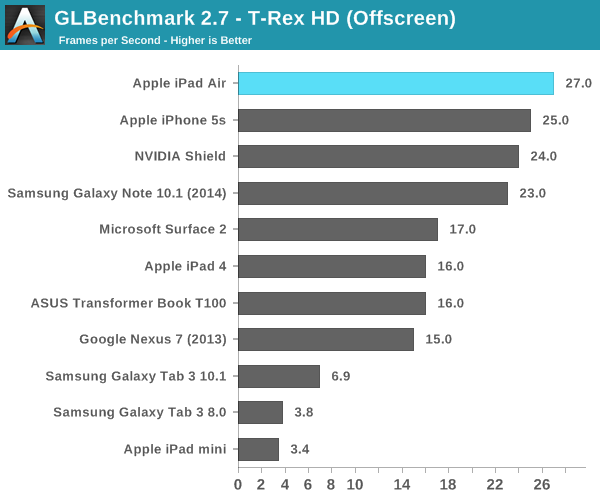
Offscreen performance sees similar scaling: ~69% better performance compared to the iPad 4.
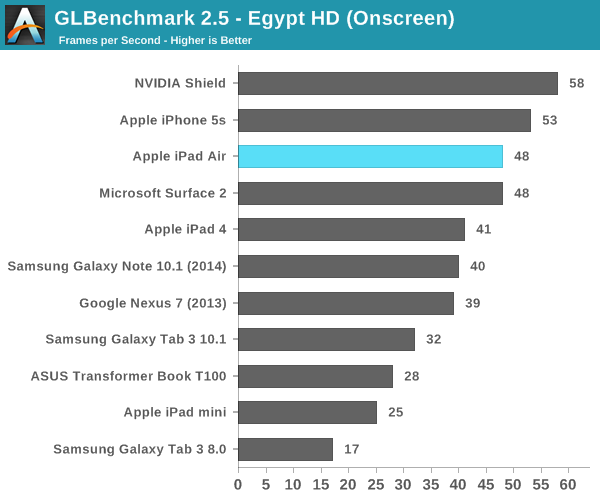
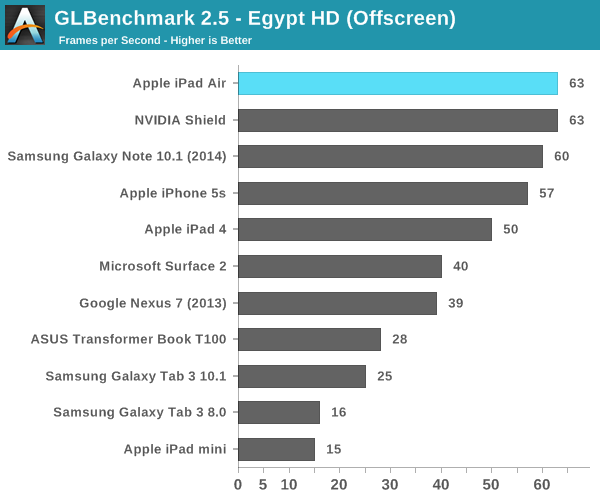
3DMark
We're once again running 3DMark's newest Unlimited mode which does its best to run independently of v-sync and at a standard resolution across all devices. I've also included 3DMark Extreme results below that feature a few more comparison points.
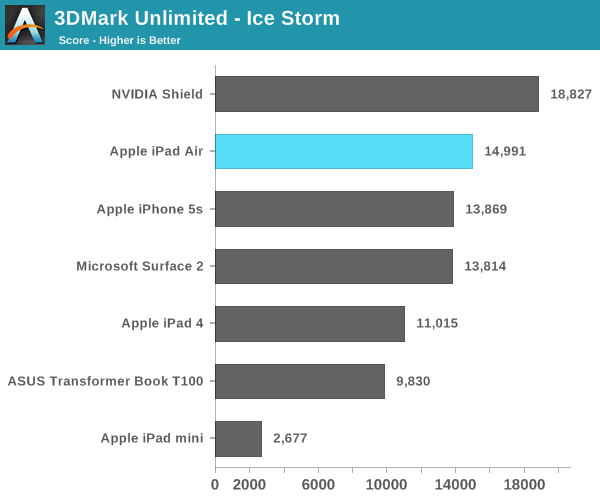
The overall Ice Storm scores show a 36% improvement in performance over the iPad 4 and an 8% increase compared to the iPhone 5s. Given the CPU frequency advantage of the A7 in the Air vs. the iPhone 5s, I'm guessing that's why we're seeing the performance gap we are here.
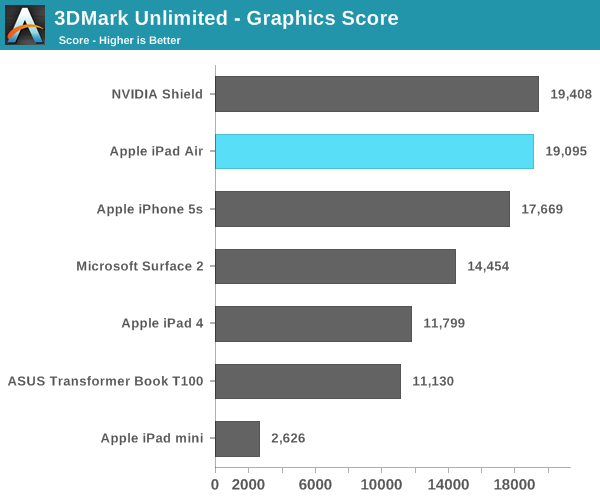
If we focus exclusively on the GPU tests (which themselves are still CPU bound), the iPad Air's performance advantage over the iPad 4 grows to over 60%.
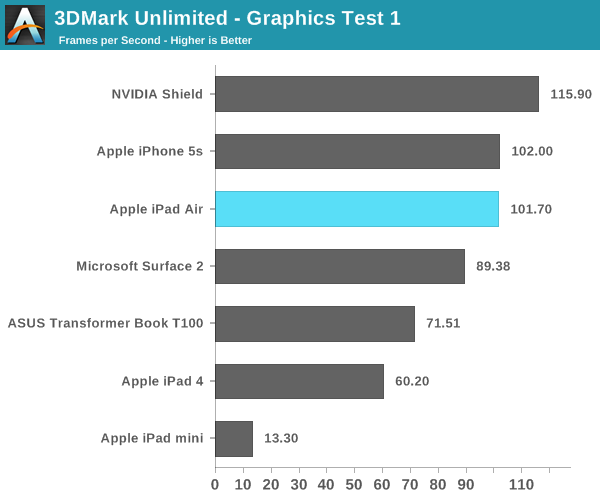
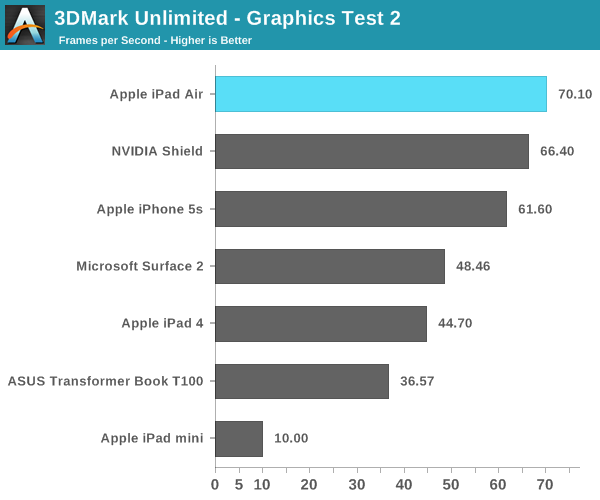
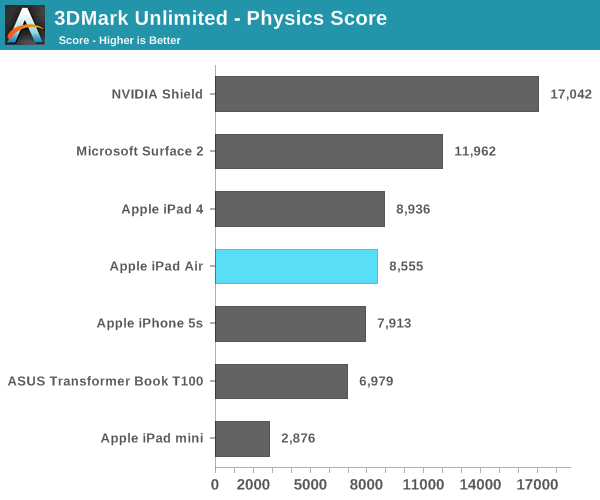
I'm still not entirely sure what's going on with the 3DMark Physics test, but we've seen this two reviews in a row now where Cyclone showed no performance increase at all compared to Swift despite this being largely a CPU test.
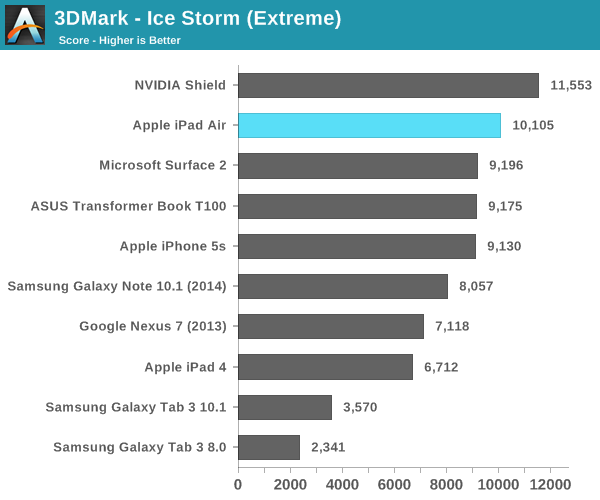
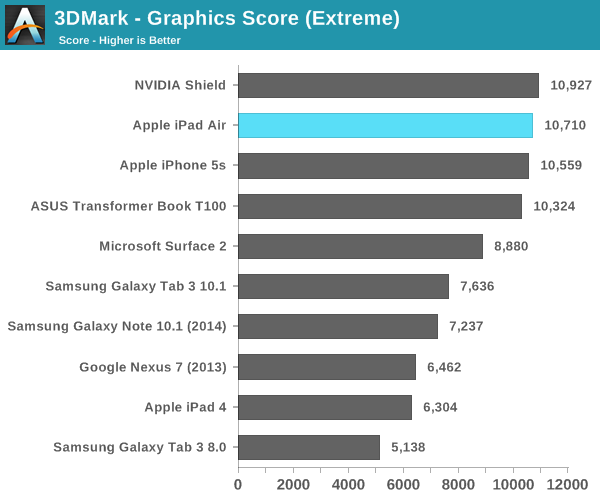
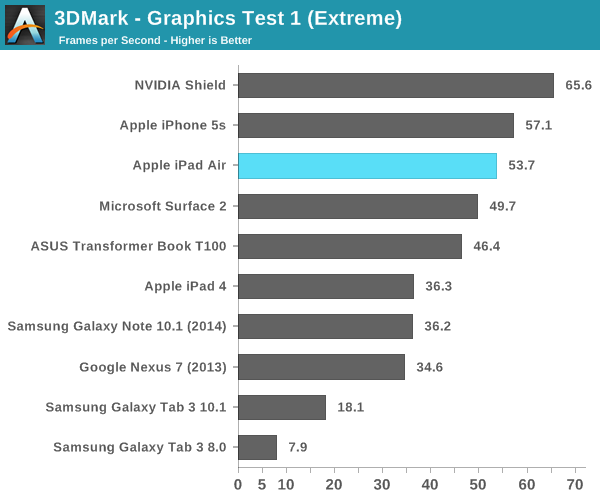
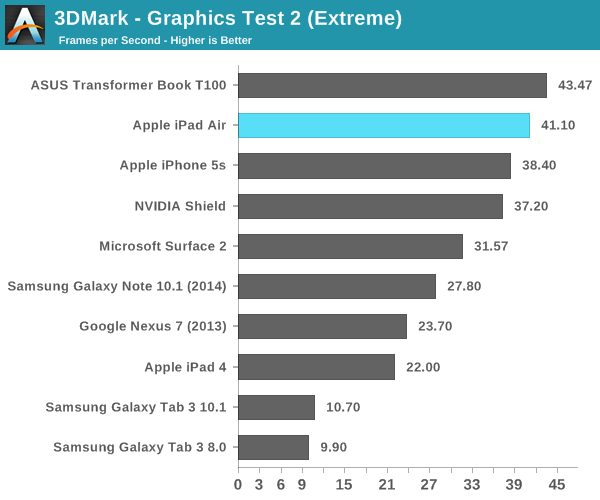

Basemark X
Basemark X is a new addition to our mobile GPU benchmark suite. There are no low level tests here, just some game simulation tests run at both onscreen (device resolution) and offscreen (1080p, no vsync) settings. The scene complexity is far closer to GLBenchmark 2.7 than the new 3DMark Ice Storm benchmark, so frame rates are pretty low.
I'm still having random issues with Basemark X reliably running both on and offscreen tests on iOS 7. Unfortunately I could only get onscreen results for the iPad Air, which came in at 46% faster than the iPad 4. Note the iPad mini and iPhone 5s benefit from having lower native resolutions here, which is why they perform so well.
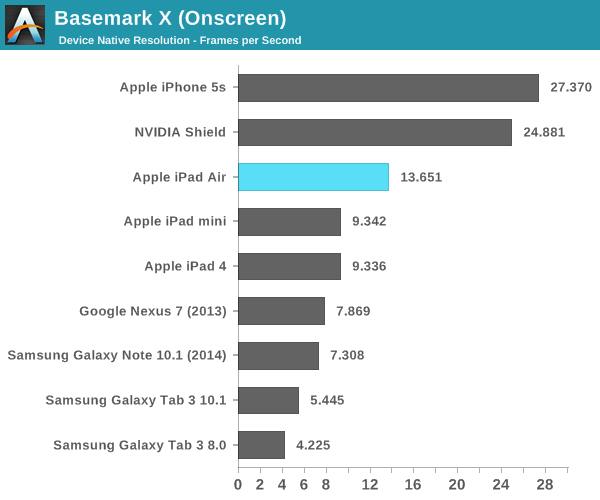










444 Comments
View All Comments
Wilco1 - Thursday, October 31, 2013 - link
Typically you run benchmarks at the maximum performance so you can compare different devices at known frequencies. A long running benchmark will always run at the maximum frequency - as long as there is no thermal throttling. So DVFS only has an effect on benchmarks which run for very short times (milliseconds like SunSpider, AnTuTu etc). This means the results are random based on the DVFS settings (hardware/software) and what you did just before starting the benchmark. That makes it hard to make fair comparisons. So setting the frequency before running a benchmark makes the results more useful.If you want to benchmark the DVFS then you need something more specific - I'm not aware of benchmarks which accurately try to measure DVFS, it's reaction speed, the power/performance tradeoff and effect on GUI interaction. The closest one is Anand's battery-life test which has idle periods followed by high activity bursts. Unfortunately he doesn't list performance of this test, only battery-life...
rynite - Friday, November 1, 2013 - link
"Typically you run benchmarks at the maximum performance so you can compare different devices at known frequencies."Oh please. Who decides how a benchmark is run? You? Or the actual benchmark authors like Anand and Futuremark, who publicly oppose this sort of behavior?
Wilco1 - Sunday, November 3, 2013 - link
Anand doesn't have a clue unfortunately. If INtel's turbo is not cheating then it is certainly not cheating to use the maximum frequency.Gondalf - Saturday, November 2, 2013 - link
Hei Wilco. IPC apart....without a SPEC submission it's hard to give a final judgment, what about A7 is only dualcore??? Anand says that A7 is the best around, but it's an absurdity !! In a multitasking workload A7 is clearly doomed by Snapdragon, Tegra, Baytrail. IMO this review is biased, A7 is good yes but only in light multithread, very bad in a serious usage, and looking at the selling price a customer is only a victim of Apple MarketingWilco1 - Sunday, November 3, 2013 - link
Yes, in terms of throughput A7 would be slower than most of the quad cores, however having the fastest single threaded performance is equally important.someonethinks - Wednesday, October 30, 2013 - link
iPad Air2 pleaseApple does it again, it will sell but device is not quite as good as it should be, do they care about the users or just the profit?
I would like
2GB and 32GB min
smooth transitions that can also be turned off / reduced
I have an iPad 2 and was looking to replace but the memory is really a big issue to future proof it, so I am VERY disappointed as I don't buy something like this every year.
With the original, I waited for the iPad 2 and was very pleased, it looks like I need to do the same again or maybe I now just go elsewhere.
xype - Wednesday, October 30, 2013 - link
Ooooor you could assume that the iPad Air is actually good enough. Because it is. Go and try it with some apps at a store and then decide; the whole making assumptions based on articles is not really helpful. Compared to an iPad 2, the iPad Air will absolutely blow you away.aliasfox - Wednesday, October 30, 2013 - link
Good enough? Yes. But for my money, "good enough" in 2013-2014 isn't enough - I want my devices to be "good enough" for a long time, especially at $500+. I kept my laptop for eight years, my previous digital camera lasted eight years, the shortest I've kept a cell phone is three and a half years, and my current desktop is seven years old with just a GPU and storage upograde (granted, that was a high end machine when it came out).Buying a device that has deficiencies *now* is questionable if you want to keep it for a while.
And don't think this is coming from a PC fanboy, either. iPad 1, iPhone 4, and Mac Pro are my primary devices.
KPOM - Wednesday, October 30, 2013 - link
By that logic, though, any Android device today has "questionable" specs since undoubtedly in a year or so most high-end Androids will have 64-bit processors. The iPad AIr, new iPad mini and iPhone 5s already have them.I think, also, that since all 3 have the same internals, we'll see developers write to those specs. I.e. lack of RAM won't be a significant issue because it isn't as if developers will be writing for devices with significantly more RAM.
suman0011 - Wednesday, October 30, 2013 - link
At every one knows apple has the leading market share in the android phones but now a days companies like Samsung are exploring the market at present Samsung has the major share in the android phone segment if i am right.in order to that apple has to found news to gain their place in the android marketas in most of the people use android phones that to Samsung phones
here you can find a link why Samsung why Samsung is in 1st place
http://indiahomedepot.com/samsung-galaxy-tab-t-211...
just look at only the specification and you can compare with apple ipad
of course all the features available in the apple also available in the Samsung can some tell why Samsung is first and Apple is trying hard to get first place?